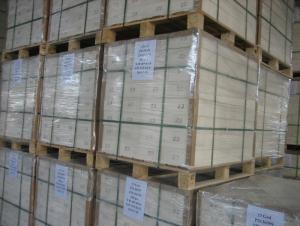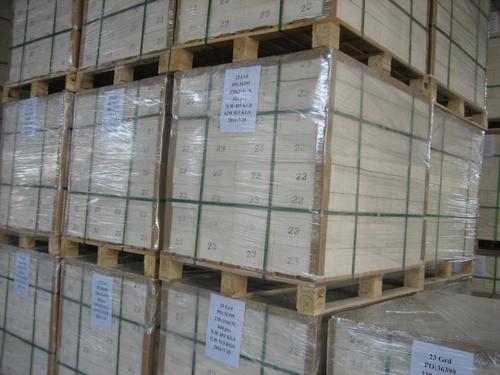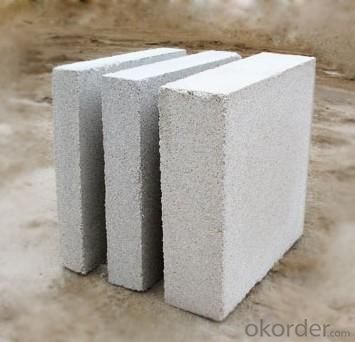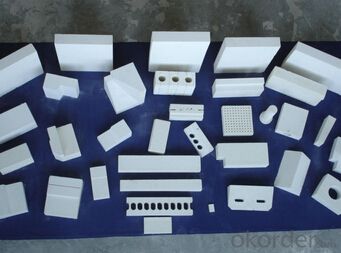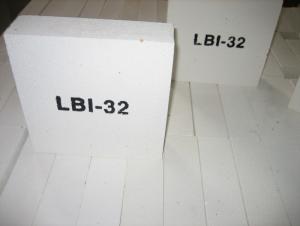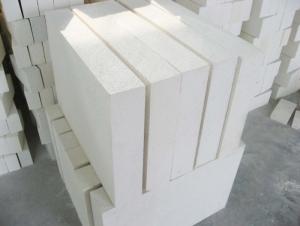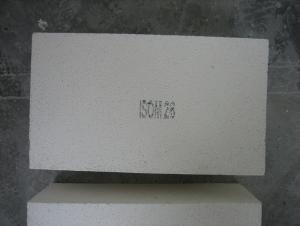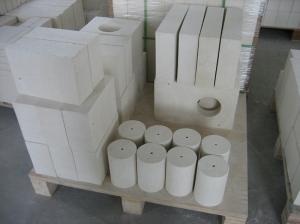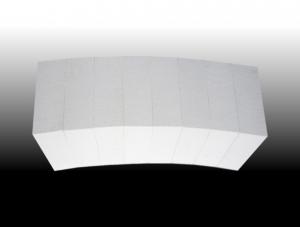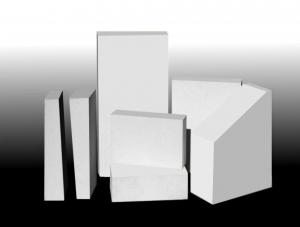Insulating Fire Brick - Refractory Mullite Insulating Refractory Brick JM 29
- Loading Port:
- Shanghai
- Payment Terms:
- TT OR LC
- Min Order Qty:
- 20 m.t.
- Supply Capability:
- 20 m.t./month
OKorder Service Pledge
OKorder Financial Service
You Might Also Like
General Information
CMAX insulating firebricks are classified under temperature between 1300℃ to 1700℃, manufactured from high purity alumina clay.
1. Lower content of iron, alkaline and impurities, good high temperature properties.
2. Homogeneous structure, light weight, energy saving because lower heat storage in the furnace during cooling cycles.
3. High strength, good thermal shock resistance under high temperature.
4. Precise sizes due to grinding and shaping after sintering, which meets the requirement of construction.
5. Max service temp: Up to 1730C (3160F)
Feature
Light weight and low thermal conductivity
Low heat storage
Low iron and impurities
High thermal shock resistance
Application of Insulating brick
Metallurgical Industry: blast furnace, hot blast furnace, heating furnace, etc..
Petrochemical Industry: ethylene cracking furnace, hydrogen furnace, the main furnace, heating furnace, etc..
Ceramic industry: roller kiln, kiln, etc..
Glass industry: glass furnace regenerator, etc.
Carbon industry: carbon furnace, etc..
Aluminum electrolysis industry: aluminum reduction cell, etc.
Other industries: tunnel kiln, shuttle kiln, etc.
Advantages of heat insulation brick
Low thermal conductivity: many air holes will bring good thermal insulation effect, energy saving.
High crushing strength: high crushing strength, volume stability.
Low heat storage: small heat storage, absorb more heat, energy-saving effect is obvious.
Technical Data
ITEM | GJM30 | GJM28 | GJM26 | GJM23 |
Classification Temperature, ℉/℃ | 3000/1650 | 2800/1540 | 2600/1430 | 2300/1260 |
Bulk Density,g/cm³ | ≤1.0 | ≤0.9 | ≤0.8 | ≥0.5 |
Reheating Linear Change, % | ≤0.9 (1550℃,12 h) | ≤0.8 (1510℃,12 h) | ≤0.7 (1410℃,12 h) | ≤0.5 (1230℃,12 h) |
Al2O3 Content, % | ≥75 | ≥65 | ≥55 | ≥45 |
Fe2O3 Content, % | ≤0.5 | ≤0.6 | ≤0.7 | ≤1.0 |
Thermal Conductivity: | ||||
800℃, w/m.k | ≤0.39 | ≤0.37 | ≤0.35 | ≤0.18 |
1000℃, w/m.k | ≤0.43 | ≤0.41 | ≤0.39 | ≤0.20 |
1200℃, w/m.k | ≤0.48 | ≤0.46 | ≤0.43 | --- |
Insulating brick
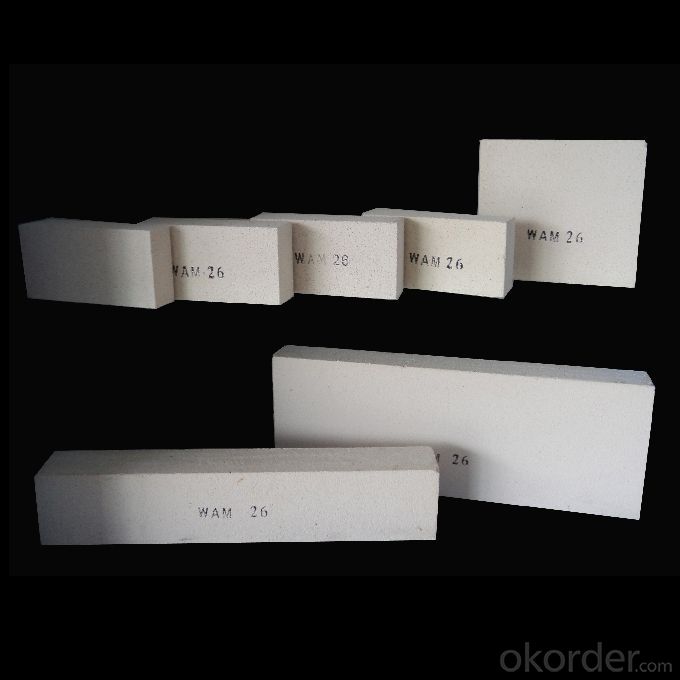
- Q: Are insulating fire bricks suitable for high-temperature kilns?
- Yes, insulating fire bricks are suitable for high-temperature kilns. They are specifically designed to withstand extreme temperatures, making them an ideal choice for insulation in kilns. These bricks are made from lightweight refractory materials that have excellent thermal conductivity properties, allowing them to effectively retain heat and minimize heat loss. Additionally, insulating fire bricks have high resistance to thermal shock, ensuring their durability and longevity in high-temperature environments.
- Q: Is the quality of brick made of small-sized self insulation block equipment the same as that of large block brick equipment?
- Recently, a lot of people have encountered this problem, Silver Horse understand, in fact, the brick machine is only the production of different production, the quality of the bricks produced are the same.
- Q: Do insulating fire bricks require any special sealing or caulking?
- Yes, insulating fire bricks typically require special sealing or caulking in certain applications. While insulating fire bricks are designed to withstand high temperatures and provide excellent thermal insulation, they can still be susceptible to moisture infiltration and atmospheric gases in specific environments. To mitigate these risks, sealing or caulking is often necessary. Sealing or caulking insulating fire bricks involves using specialized refractory materials or compounds that are resistant to high temperatures and can create an airtight barrier. The sealing process helps to prevent the ingress of moisture, gases, or other contaminants that could compromise the insulating properties of the bricks. The specific sealing or caulking method will depend on the application and the type of insulating fire bricks being used. Some common sealing techniques include using high-temperature silicone sealants, refractory mortars, or coatings. These materials are specifically formulated to withstand the extreme temperatures experienced in high-heat environments. It is important to consult the manufacturer's guidelines or seek professional advice when determining the appropriate sealing or caulking method for insulating fire bricks. Proper sealing ensures the longevity and effectiveness of the insulation, as well as the overall performance and safety of the application.
- Q: Can insulating fire bricks be used in the construction of aluminum smelting furnaces?
- Yes, insulating fire bricks can be used in the construction of aluminum smelting furnaces. Insulating fire bricks are made from lightweight materials such as refractory clay and have high insulating properties. This makes them ideal for use in high-temperature environments, such as aluminum smelting furnaces, where they can help to conserve heat and improve energy efficiency. Aluminum smelting furnaces typically operate at very high temperatures, often above 1000 degrees Celsius. In these extreme conditions, insulating fire bricks can provide effective thermal insulation, which helps to reduce heat loss and maintain the desired temperature inside the furnace. This insulation can also help to reduce the energy required to heat the furnace, leading to cost savings and increased efficiency. Additionally, insulating fire bricks have excellent resistance to thermal shock, meaning they can withstand rapid temperature changes without cracking or breaking. This is important in an aluminum smelting furnace, where the heating and cooling cycles can be frequent and rapid. Another advantage of using insulating fire bricks in aluminum smelting furnaces is their low thermal conductivity. This property allows them to retain heat within the furnace, preventing it from escaping to the surrounding environment. By reducing heat loss, insulating fire bricks can help to maintain a consistent temperature throughout the smelting process, ensuring optimal conditions for the melting and refining of aluminum. In summary, insulating fire bricks are a suitable choice for the construction of aluminum smelting furnaces due to their high insulating properties, resistance to thermal shock, and low thermal conductivity. Their use can help to improve energy efficiency, reduce heat loss, and maintain a stable temperature within the furnace.
- Q: Can insulating fire bricks be used in the construction of BBQ pits?
- Indeed, the utilization of insulating fire bricks is feasible for the construction of BBQ pits. These bricks are specifically engineered to endure extreme temperatures and possess exceptional heat resistance attributes, rendering them perfectly suited for BBQ pit applications. By incorporating these bricks, heat is effectively captured and evenly dispersed, leading to improved cooking efficiency and a more enjoyable BBQ experience. Moreover, the inclusion of insulating fire bricks aids in minimizing heat dissipation, guaranteeing that the BBQ pit retains and sustains heat for an extended duration. All in all, the integration of insulating fire bricks significantly enhances the overall performance and longevity of the BBQ pit.
- Q: Do insulating fire bricks require any special installation techniques?
- Yes, insulating fire bricks require special installation techniques. These bricks are typically lightweight and have low thermal conductivity, making them highly effective in insulating applications. To ensure proper installation, it is important to follow the manufacturer's guidelines and use appropriate tools, such as refractory mortar or adhesive, to securely bond the bricks together. Additionally, proper curing and drying procedures should be followed to avoid any potential cracking or damage during the installation process.
- Q: Can insulating fire bricks be used in ladle covers?
- Ladle covers can indeed incorporate insulating fire bricks, which are specifically designed with low thermal conductivity to effectively insulate and retain heat. These bricks find their application in foundries and other high-temperature industries to maintain the heat of molten metal or other materials and prevent heat loss. By employing insulating fire bricks in ladle covers, heat retention is enhanced, resulting in improved energy efficiency and reduced fuel consumption. Furthermore, these bricks exhibit high refractory properties, enabling them to withstand the extreme temperatures and thermal shock encountered by ladles. All in all, insulating fire bricks prove to be an exceptional choice for ladle covers, contributing to temperature stability and heat preservation.
- Q: Are insulating fire bricks resistant to chlorine gas?
- Generally, insulating fire bricks possess resistance to chlorine gas. These bricks are composed of refractory materials that are formulated to endure high temperatures and combat chemical corrosion. As chlorine gas is highly reactive, it has the potential to corrode or harm various materials. However, insulating fire bricks exhibit a strong resistance to chemical attack, thereby making them appropriate for situations where exposure to chlorine gas is likely. It should be noted that the composition and quality of these bricks may differ, hence it is advisable to consult the manufacturer or supplier for precise details regarding their resistance to chlorine gas.
- Q: Can insulating fire bricks be used in residential applications, such as fireplaces or ovens?
- Residential applications like fireplaces or ovens can indeed utilize insulating fire bricks. These bricks are specifically designed for enduring high temperatures and providing outstanding thermal insulation. They are crafted from lightweight materials like clay or alumina, which possess low thermal conductivity. This attribute assists in retaining the heat within the fireplace or oven, enhancing efficiency and reducing energy consumption. Moreover, insulating fire bricks exhibit exceptional resilience against thermal shock, enabling them to withstand sudden temperature fluctuations without cracking or breaking. Additionally, these bricks are non-combustible, ensuring they can withstand the intense temperatures produced in fireplaces or ovens without posing a fire hazard. Consequently, insulating fire bricks are a suitable option for residential applications requiring high temperatures and thermal insulation.
- Q: Are insulating fire bricks resistant to carbon monoxide?
- Yes, insulating fire bricks are resistant to carbon monoxide.
Send your message to us
Insulating Fire Brick - Refractory Mullite Insulating Refractory Brick JM 29
- Loading Port:
- Shanghai
- Payment Terms:
- TT OR LC
- Min Order Qty:
- 20 m.t.
- Supply Capability:
- 20 m.t./month
OKorder Service Pledge
OKorder Financial Service
Similar products
Hot products
Hot Searches
Related keywords
